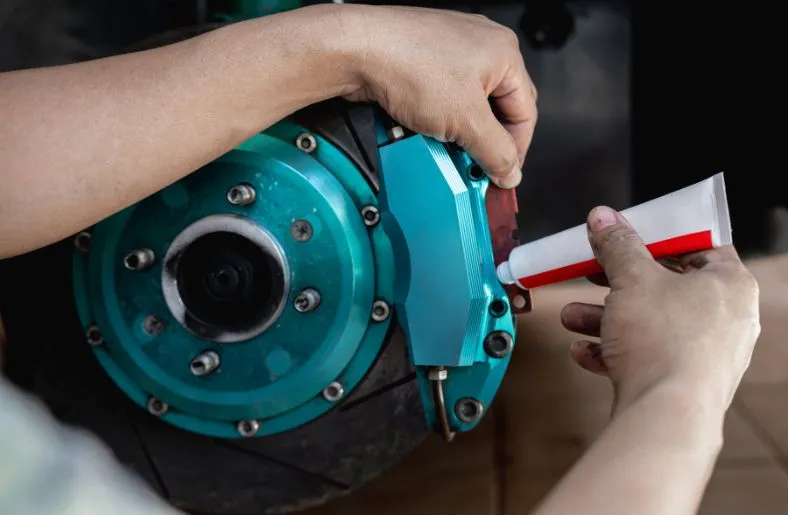When it comes to the world of mechanical engineering, maintenance, and repair, preventing friction and corrosion is paramount. One indispensable tool in achieving this goal is an anti-seize compound. Anti-seize is a specialized lubricant used in a variety of applications to prevent the seizing, galling, and corrosion of metal components.
In this comprehensive guide, we will delve into the fascinating world of anti-seize compounds, exploring their composition, how does anti-seize work, applications, and best practices.
Table of Contents
Anti-Seize Compound and How Does Anti-Seize Work
Composition
Anti-seize compounds are specially formulated lubricants designed to reduce friction and prevent corrosion between metal surfaces, particularly in high-temperature and high-pressure environments. They typically consist of a base lubricant and a combination of solid lubricants and additives. The base lubricant is often a high-quality grease or oil, chosen for its ability to adhere to metal surfaces and provide long-lasting lubrication.
Solid lubricants, such as graphite, molybdenum disulfide, and copper, are added to enhance the compound’s lubricating properties. These solid lubricants act as microscopic ball bearings, reducing the direct metal-to-metal contact that can lead to friction, wear, and galling.
Additives are incorporated to improve the compound’s performance under specific conditions. For instance, anti-seize compounds designed for use in extreme temperatures may contain high-temperature additives, while those used in corrosive environments may contain corrosion inhibitors.
How Does Anti-Seize Work
Basically, the answer to the question how does anti-seize work? is that anti-seize compounds create a protective barrier between metal surfaces, thereby preventing direct contact and the resulting friction and wear. Here’s a closer look at how does anti-seize work and how they achieve this:
- Barrier Formation: When anti-seize is applied to metal surfaces, it adheres firmly, creating a thin but robust barrier. This barrier acts as a shield that prevents metal-to-metal contact.
- Solid Lubricant Functionality: The solid lubricants present in the compound play a crucial role. As the metal surfaces move against each other, the solid lubricant particles shear off, providing a low-friction, cushioning effect. This reduces friction and minimizes wear and tear.
- Corrosion Prevention: Anti-seize compounds are highly effective at preventing corrosion. The corrosion inhibitors present in the compound create a protective layer on the metal’s surface, shielding it from moisture, oxygen, and other corrosive elements.
- Temperature Resistance: Anti-seize compounds are designed to withstand extreme temperatures. When exposed to high heat, they continue to provide lubrication and protection, preventing components from seizing or welding together due to heat-induced expansion.
Applications of Anti-Seize Compound
Anti-seize compounds find a wide range of applications across various industries. Some of the most common uses include:
- Automotive Industry: Anti-seize compound is widely used in the automotive industry for lubricating threaded fasteners, such as spark plugs, exhaust manifold bolts, wheel studs, and brake caliper bolts. It helps prevent corrosion, galling, and seizing of these components, making disassembly and maintenance easier.
- Marine Equipment and Boating: In marine environments, where exposure to saltwater and corrosion is prevalent, anti-seize compound is applied to fasteners and fittings on boats, ships, and marine equipment. It protects against galvanic corrosion and facilitates maintenance and repair of critical components.
- Industrial Machinery and Equipment: Anti-seize compound is used in various industrial applications to lubricate threaded connections, flanges, gaskets, and other mechanical components. It is particularly valuable in high-temperature environments, such as foundries, steel mills, and power plants, where metal-to-metal contact can lead to friction and wear.
- Aerospace and Aviation: In the aerospace and aviation sectors, where reliability and safety are paramount, anti-seize compound is applied to fasteners and components in aircraft engines, airframes, and hydraulic systems. It helps prevent corrosion and fretting, ensuring the integrity of critical assemblies.
- Mining and Heavy Equipment: Anti-seize compound is utilized in mining operations and heavy equipment industries to protect threaded connections, bolts, and nuts from corrosion, vibration, and thermal cycling. It enhances the longevity of equipment and minimizes downtime for maintenance and repairs.
- Oil and Gas Exploration: In oil and gas exploration and production facilities, anti-seize compound is employed to lubricate and protect threaded connections on drilling equipment, wellheads, valves, and pipelines. It helps prevent galling and seizing, ensuring the integrity of critical infrastructure in harsh environments.
- Construction and Infrastructure: Anti-seize compound finds application in construction projects and infrastructure maintenance, where threaded fasteners and mechanical components are exposed to weathering, vibration, and environmental contaminants. It aids in assembly and disassembly of structural elements, such as bridges, towers, and industrial machinery.
- Food Processing and Pharmaceutical Industries: In food processing and pharmaceutical manufacturing facilities, where cleanliness and hygiene are essential, anti-seize compound formulated with FDA-approved ingredients is used to lubricate and protect equipment components. It complies with regulatory standards and ensures product integrity during processing.
- Electrical and Electronics: Anti-seize compound is utilized in electrical and electronics industries to prevent corrosion and ensure reliable electrical connections. It is applied to threaded terminals, bus bars, and connectors to maintain conductivity and prevent oxidation in harsh operating environments.
- Maintenance and Repair Applications: Anti-seize compound is a valuable tool for general maintenance and repair tasks in various industries and applications. It is used to lubricate bolts, nuts, studs, and other threaded connections, making them easier to assemble, disassemble, and service.
By highlighting these applications, users can understand the versatility and importance of anti-seize compound and how does anti-seize work in various industries and settings, promoting informed decision-making and effective utilization of this lubricating and protective product.
Best Practices for Using Anti-Seize
To get the most out of anti-seize compounds, it’s essential to follow best practices:
- Surface Preparation: Before applying anti-seize, ensure that the surfaces to be treated are clean and free of dirt, rust, corrosion, or old lubricants. Use a suitable solvent or degreaser to clean the surfaces thoroughly and allow them to dry completely before applying the anti-seize.
- Proper Application: Apply a thin, even coat of anti-seize to the threaded or mating surfaces using a brush, applicator, or aerosol spray. Avoid applying excessive amounts of anti-seize, as this can lead to messy buildup and potential contamination of surrounding areas.
- Use of Correct Type: Select the appropriate type of anti-seize based on the materials and conditions involved. Different formulations of anti-seize are available for specific applications, such as high-temperature environments, stainless steel, aluminum, or copper-based alloys. Consult the manufacturer’s recommendations or specifications for guidance on choosing the right type of anti-seize for your application.
- Temperature Considerations: Take into account the temperature range and operating conditions of the application when selecting anti-seize. Some anti-seize compounds are designed to withstand extreme temperatures, while others may degrade or become less effective at high temperatures. Choose an anti-seize that can withstand the temperatures encountered during operation.
- Torque Adjustment: Adjust torque values when using anti-seize to ensure proper fastener tension. Anti-seize can reduce friction between threaded surfaces, potentially leading to over-tightening if torque values are not adjusted accordingly. Consult torque specifications or guidelines provided by the equipment manufacturer for proper torque adjustment when using anti-seize.
- Reapplication During Maintenance: Periodically inspect and reapply anti-seize during routine maintenance intervals or whenever disassembly and reassembly of components are performed. Over time, anti-seize may wear off or become contaminated, necessitating reapplication to maintain effective lubrication and corrosion protection.
- Storage and Handling: Store anti-seize in a cool, dry place away from direct sunlight and sources of heat or ignition. Proper storage helps maintain the integrity and effectiveness of the anti-seize compound. Follow handling instructions provided by the manufacturer to minimize exposure and ensure safety during application.
- Avoid Contamination: Take precautions to prevent contamination of the anti-seize compound during application. Use clean tools and equipment, and avoid cross-contamination with other lubricants or substances. Contaminants can compromise the performance of the anti-seize and lead to issues such as galling or seizing of threaded connections.
- Safety Precautions: Wear appropriate personal protective equipment, such as gloves and safety glasses, when handling and applying anti-seize. Some formulations may contain chemicals or additives that can irritate the skin or eyes. Follow safety guidelines provided by the manufacturer and observe proper handling practices to minimize risks.
Related Guide: Is Vaseline a Good Lubricant for Metal Roofs? (2023-2024)
Conclusion
In the world of mechanical engineering and maintenance, anti-seize compounds are unsung heroes. They play a critical role in preventing friction, galling, and corrosion, ensuring the longevity and reliability of various components in a wide range of industries. Understanding how does anti-seize work and using it correctly can save time, money, and headaches in the long run.
So, the next time you’re working on a project that involves metal components, don’t forget to reach for that trusty anti-seize compound to keep things running smoothly.

